Application of a New Anchorage towards the Flexural Strengthening of RC Rectangular Beams with External Steel Tendons
Abstract
:1. Introduction
2. Experimental Section
2.1. Test Variables
2.2. Material Properties
2.3. Production of Beams
2.4. Prestressing
2.5. Loading and Measurements
3. Losses in Prestressed External Tendon
4. Test Results and Discussion
4.1. Failure Modes
4.2. Load-Deflection Relationship
4.3. Strain Behavior
5. Ductility
6. Inelastic Energy
7. Conclusions
- (1)
- The beams that were prestressed with an external tendon showed significant increases in both their yield load and ultimate load compared with the control beam. In particular, the yield and ultimate loads of the beams with the newly proposed anchorage increased by 110% to 148%, and 132% to 140%, respectively, relative to the control beam. The increases at each load (yield and ultimate) are approximately twice as high as those of the conventional anchorages, indicating that the proposed anchorage has better reinforcing effects.
- (2)
- As increasing the prestress forces applied to the steel rebar mounted in the lifting hole, the yield and ultimate loads of the prestressed beams increased by 7% to 14%, and 2% to 3%, respectively. The incorporation of the prestressed steel rebar significantly affected the yield load of the beams, but had almost no effects on the ultimate load.
- (3)
- Compared with the control beam, the prestressed beams exhibited very low ductility. Furthermore, in the same way as for the ductility, the prestressed beams had a lower inelastic energy than the control beam. However, the beams using the newly proposed anchorage showed a higher inelastic energy than those with the conventional anchorage.
- (4)
- In the beams with the conventional anchorage, problems such as cracks around the anchorage, stud bolts pull-out, and local failure of the anchorage arose. However, the newly proposed anchorage exhibited no such problems, and instead, behaved stably at the ultimate load, with only the epoxy being expelled from the concrete. This was caused by the proposed anchorage having a structurally superior shape, which enables the efficient transmission of the prestress force.
Acknowledgments
Author Contributions
Conflicts of Interest
References
- Stewart, M.G.; Rosowsky, D.B. Time-dependent reliability of deteriorating reinforced concrete bridge decks. Struct. Saf. 1998, 20, 91–109. [Google Scholar] [CrossRef]
- Park, S.K.; Joe, S.I. Bridge Maintenance and Management; Il Kwang: Seoul, Korea, 2005. [Google Scholar]
- Song, G.; Shayan, A. Corrosion of Steel in Concrete: Causes, Detection and Prediction; ARRB Transport Research: Vermont South, Australia, 1998. [Google Scholar]
- L-Amoundi, O.S. Durability of reinforced concrete in aggressive sabhka environments. ACI Mater. J. 1995, 92, 236–245. [Google Scholar]
- Mien, T.V.; Stitmannaithum, B.; Nawa, T. Simulation of chloride penetration into concrete structures subjected to both cyclic flexural loads and tidal effects. Comput. Concr. 2009, 6, 421–435. [Google Scholar] [CrossRef]
- Hanjari, K.Z. Structural Behavior of Deteriorated Concrete Structures. Ph.D. Thesis, Chalmers University of Technology, Gothenburg, Sweden, 2010. [Google Scholar]
- Suntharavadivel, T.G.; Aravinthan, T. Overview of external post-tensioning in bridges. In Proceedings of the Southern Region Engineering Conference (SREC), Toowoomba, Australia, 15 October 2005.
- Naaman, A.E. Prestressed Concrete Analysis and Design, 3rd ed.; Techno Press 3000: Ann Arbor, MI, USA, 2012. [Google Scholar]
- Roger, A.D. Methods of Increasing the Live Load Capacity of Existing Highway Bridges; National Academy Press: Washington DC, WA, USA, 1997. [Google Scholar]
- AASHTO. Standard Specifications for Highway Bridges, 17th ed.; American Association of State Highway and Transportation Officials: New York, NY, USA, 2002. [Google Scholar]
- Miyamoto, A.; Tei, K.; Nakamura, H.; Bull, J. Behavior of prestressed beams strengthened with external tendons. J. Struct. Eng. 2000, 126, 1033–1044. [Google Scholar] [CrossRef]
- Aparicio, A.C.; Ramos, G.; Cass, J.R. Testing of externally prestressed concrete beams. Eng. Struct. 2002, 24, 77–84. [Google Scholar] [CrossRef]
- Ghallab, A.; Beeby, A.W. Factors affecting the external prestressing stress in externally strengthened prestressed concrete beams. Cem. Concr. Compos. 2005, 27, 945–957. [Google Scholar] [CrossRef]
- Lee, S.; Hong, S.; Han, K.; Park, S.K. Structural behavior of RC beams strengthened with external tendons using the lifting hole anchorage system. J. Korea Inst. Struct. Maint. Insp. 2008, 12, 98–107. [Google Scholar]
- Bae, J. Behavior of a PSC Beam Externally Strengthened with an Improved Anchorage System Using a Lifting Hole. Master’s Thesis, Sungkyunkwan University, Seoul, Korea, 2009. [Google Scholar]
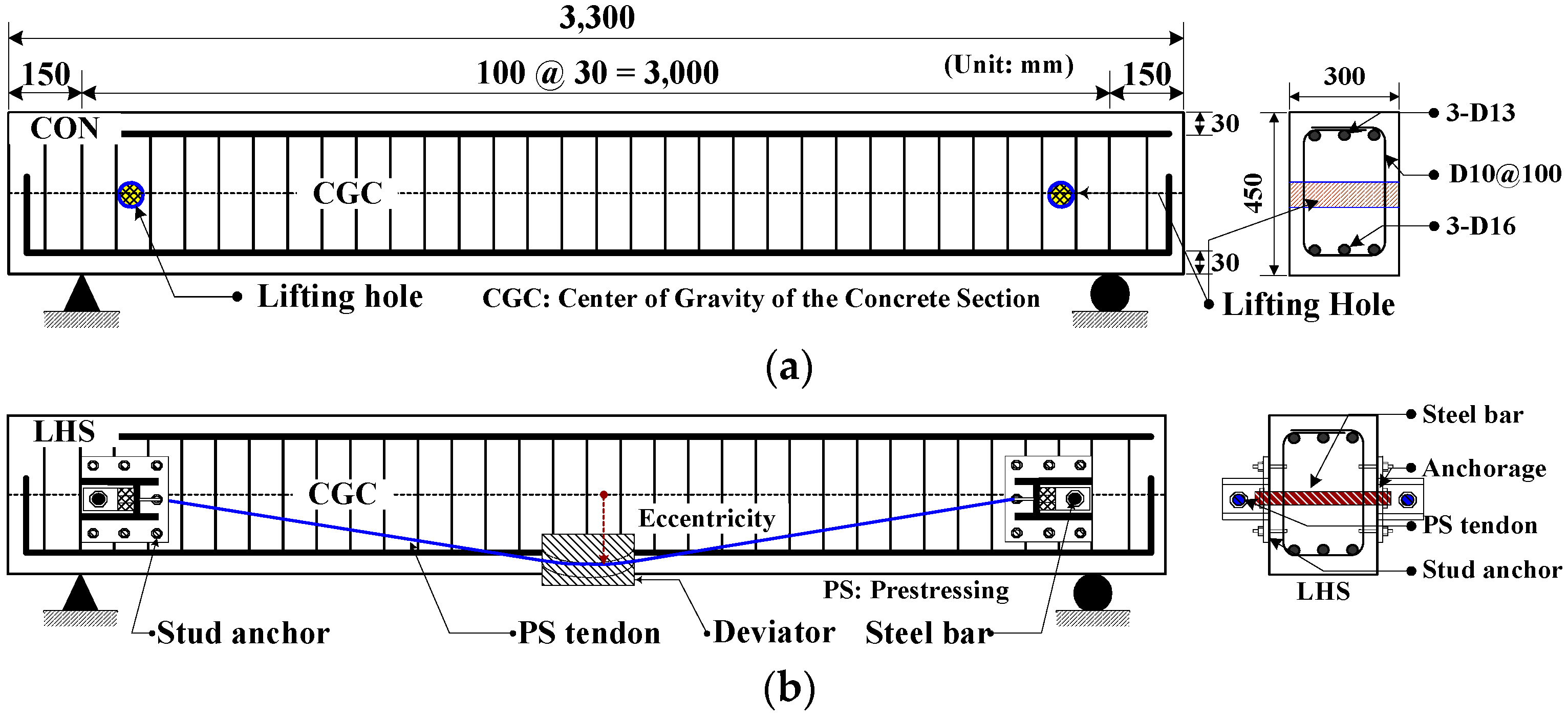
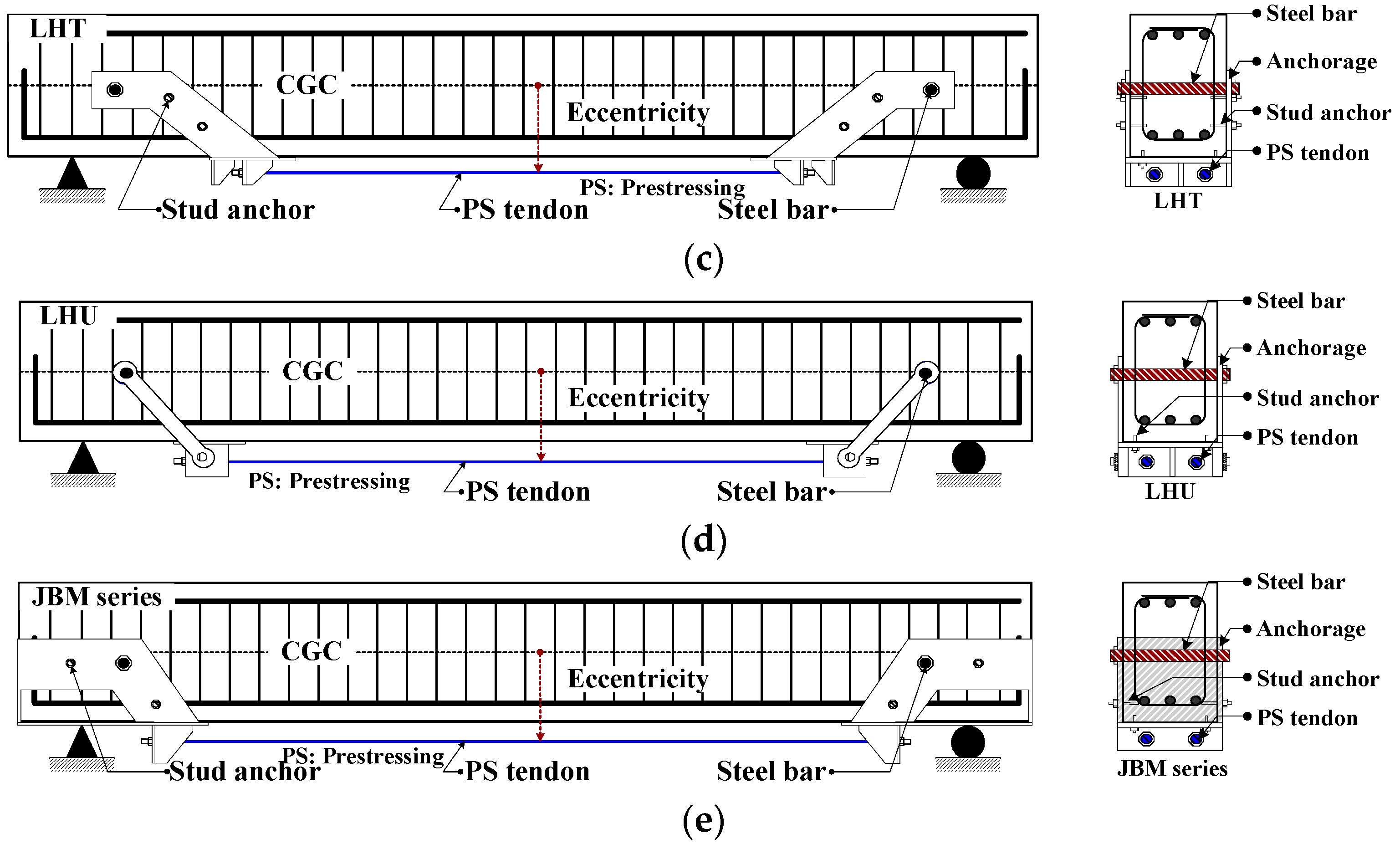

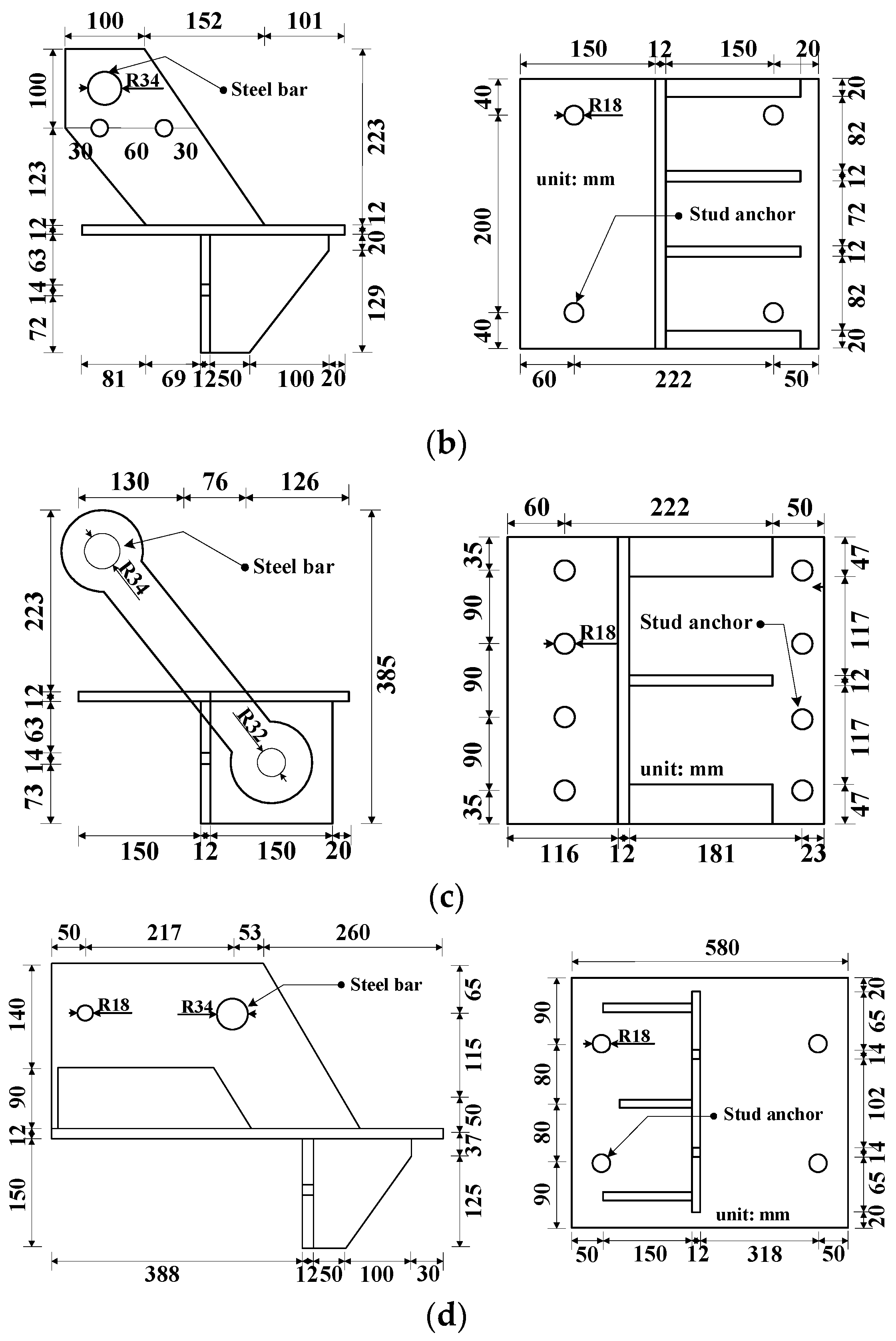
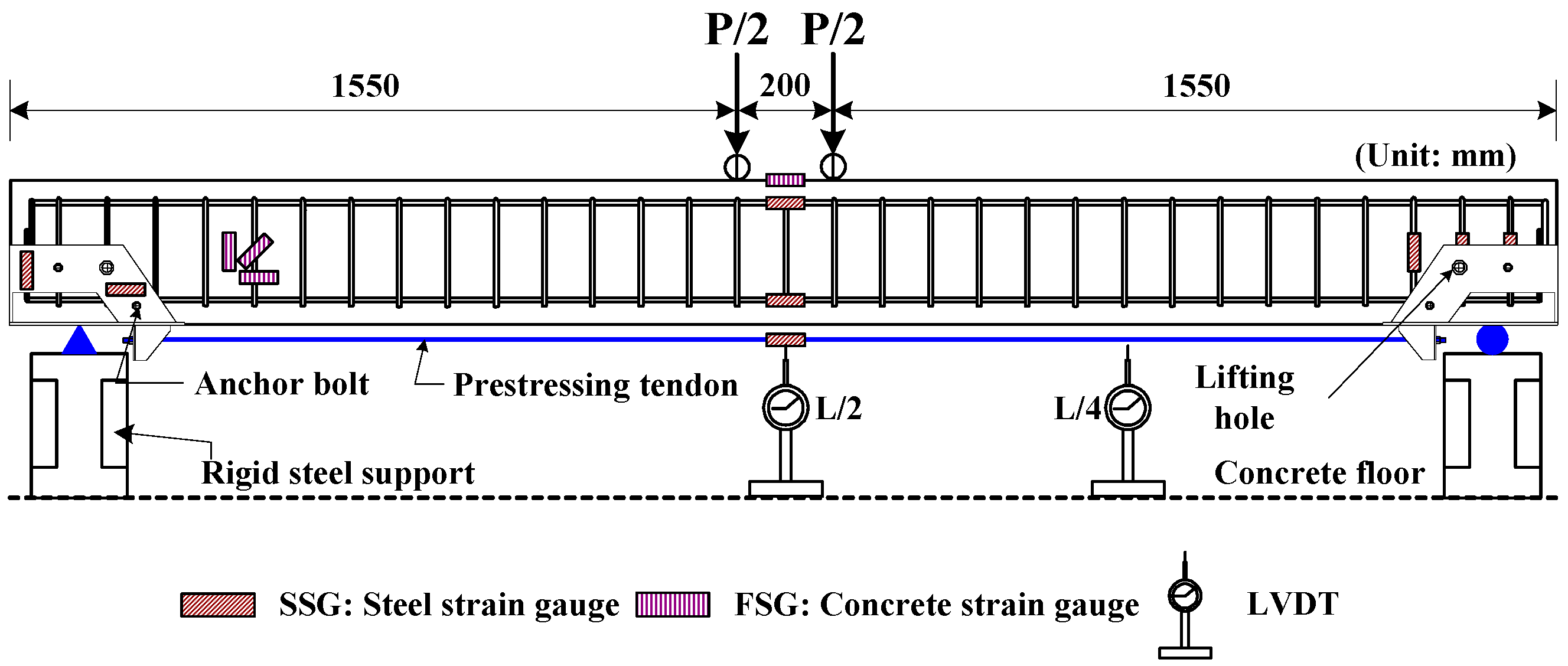

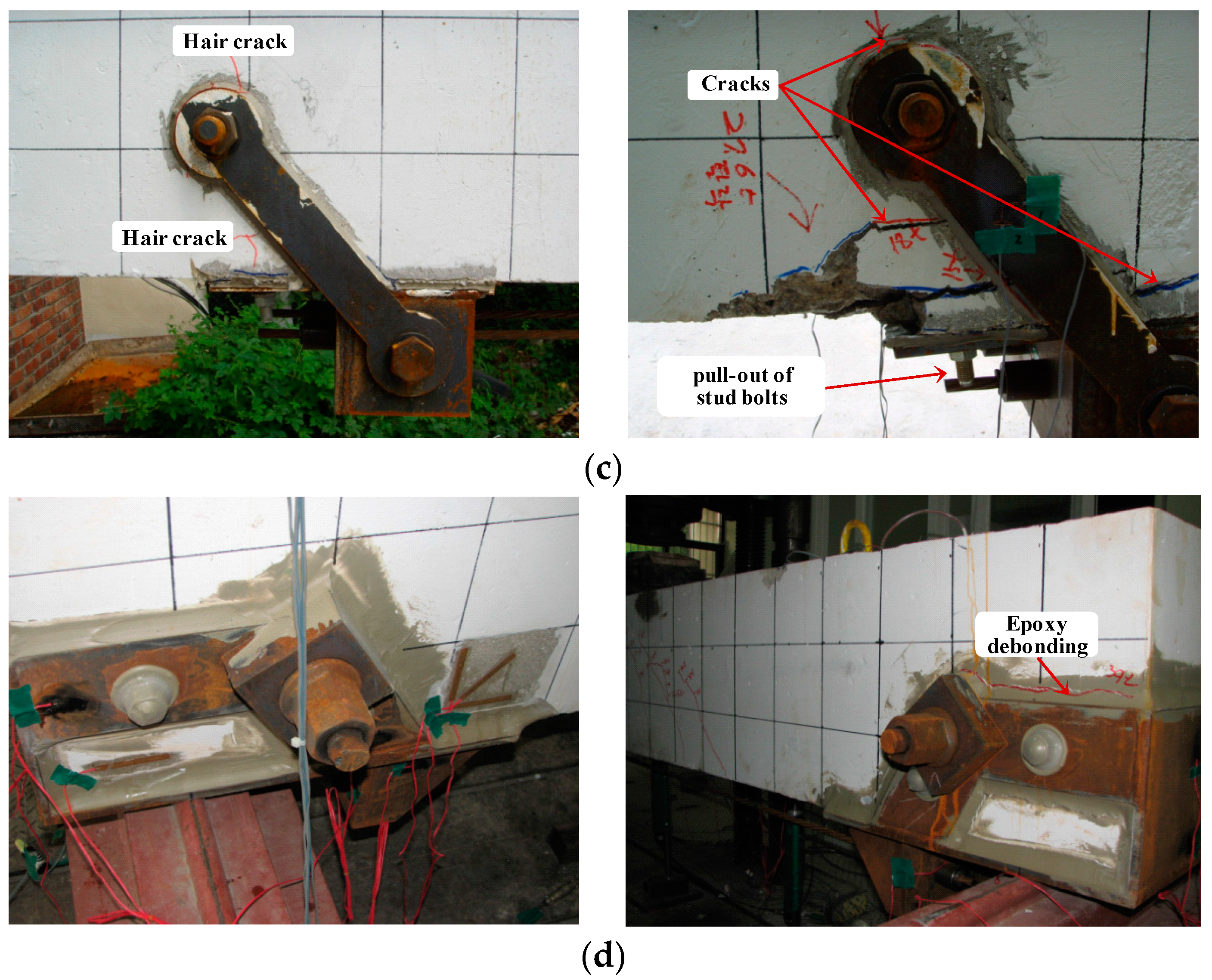
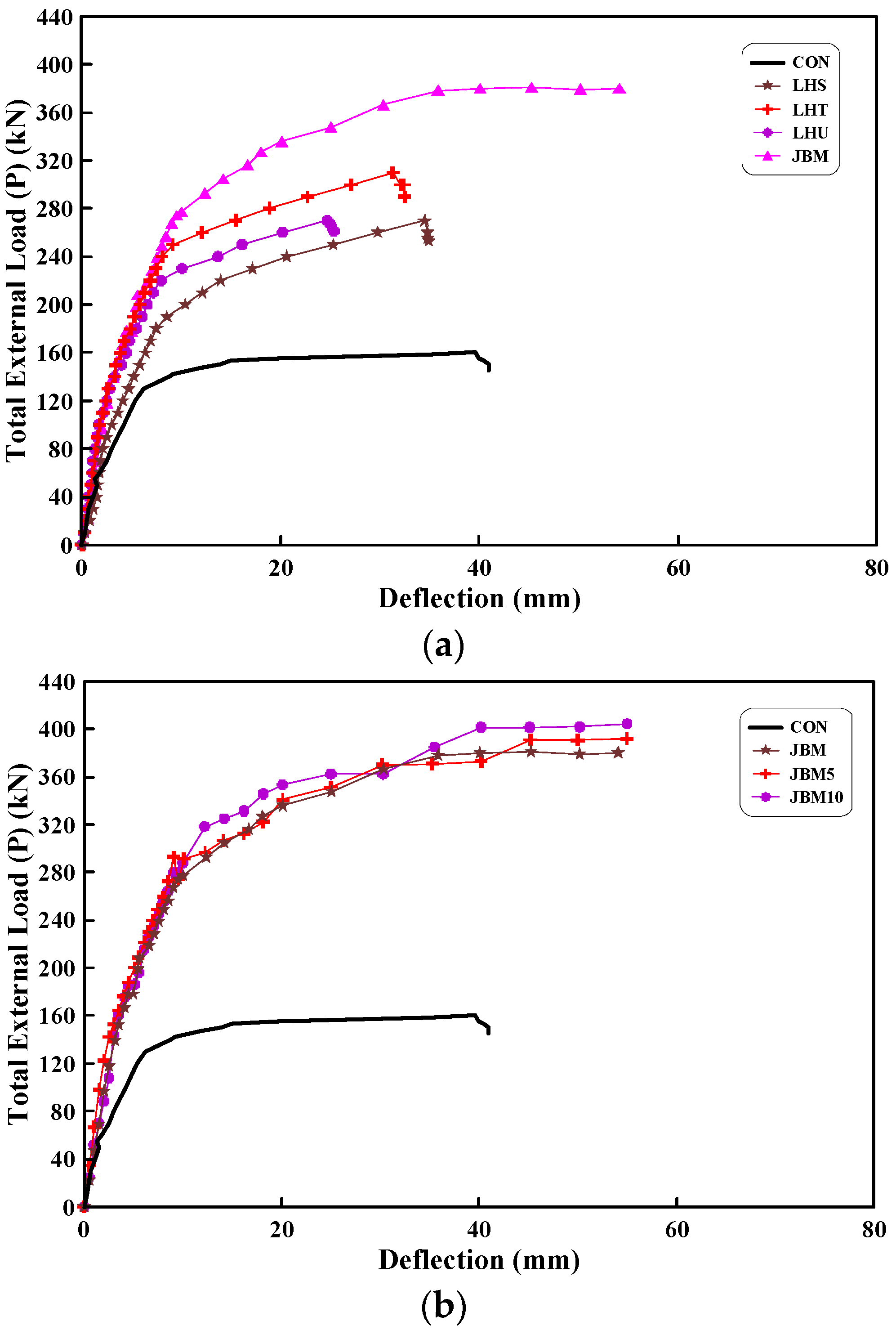
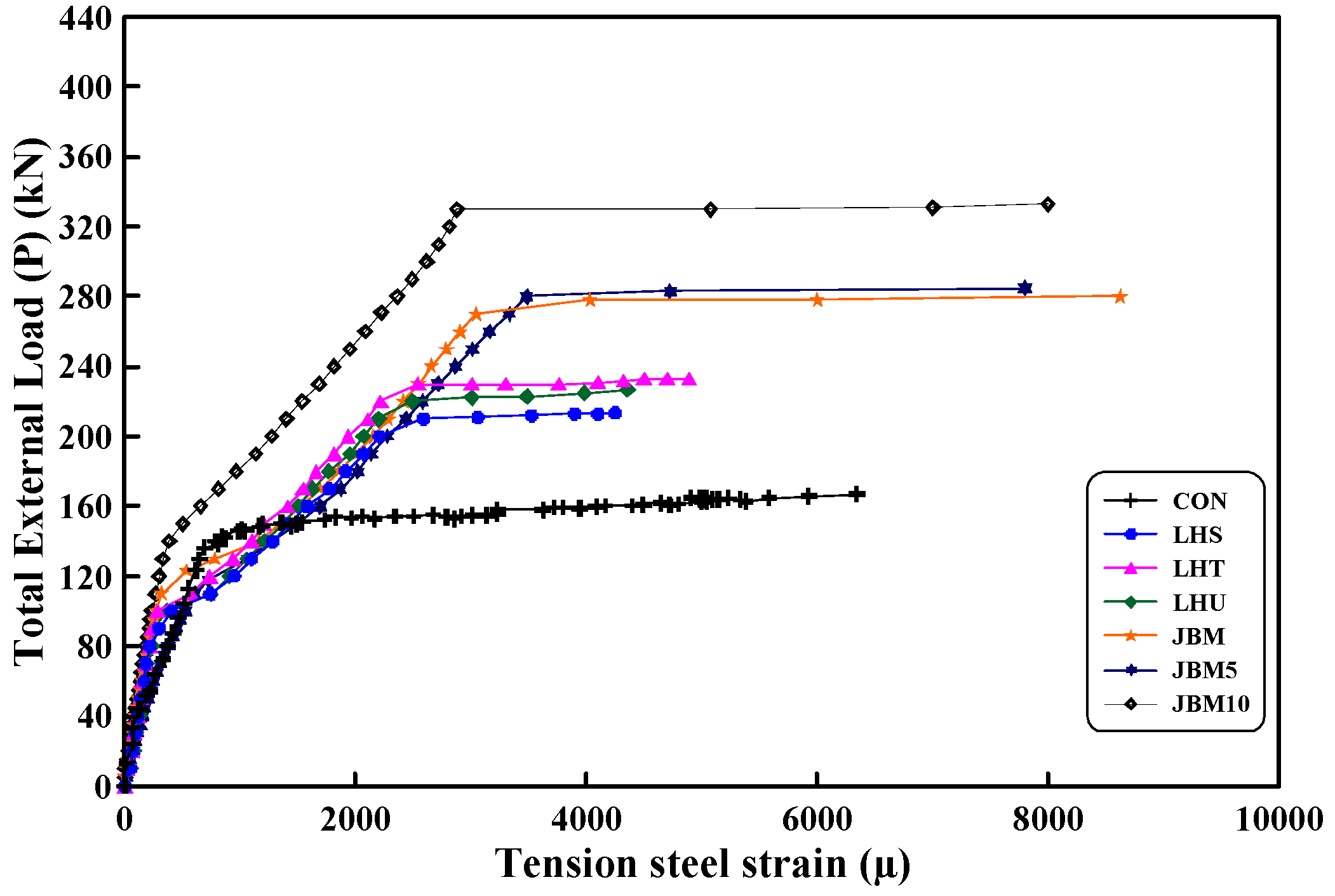



| Specimen | Concrete Strength | Prestressing Tendon | Steel Rebar | Anchorage Shape | |||
|---|---|---|---|---|---|---|---|
| Eccentricity | Prestress Force for two Tendons | Layout | Prestress Force | ||||
| (MPa) | (mm) | (kN) | (-) | (kN) | (-) | ||
| Control Beam | CON | 30 | - | - | - | - | - |
| Conventional Anchorage | LHS | 140 | 190 | Draped | - | Type I | |
| LHT | 280 | 95 | Straight | - | Type II | ||
| LHU | 280 | 95 | Straight | - | Type III | ||
| Newly Proposed Anchorage | JBM | 280 | 95 | Straight | - |  | |
| JBM5 | 280 | 95 | Straight | 50 | |||
| JBM10 | 280 | 95 | Straight | 100 | |||
| Beams | Prestressed External Tendon | Prestress Loss | ||||
|---|---|---|---|---|---|---|
| At Introduction | At Testing | |||||
| Target Strain | Prestress Force | Residual Strain | Prestress Force | Reduced Strain | Reduced Force | |
| (μ) | (kN) | (μ) | (kN) | (μ) | (kN) | |
| LHS | 4812.1 | 95.0 | 4458.3 | 88.0 | 353.8 | 7.0 |
| LHT | 2406.0 | 47.5 | 2246.3 | 44.3 | 159.7 | 3.2 |
| LHU | 2406.0 | 47.5 | 2298.2 | 45.4 | 107.8 | 2.1 |
| JBM | 2406.0 | 47.5 | 2492.2 | 49.2 | −86.2 | −1.7 |
| JBM5 | 2406.0 | 47.5 | 2475.6 | 48.9 | −69.6 | −1.4 |
| JBM10 | 2406.0 | 47.5 | 2453.1 | 48.4 | −47.1 | −0.9 |
| Beam | External Total Load (P) | Load Increase Rate | |||||
|---|---|---|---|---|---|---|---|
| Cracking Load | Yield Load | Ultimate Load | Anchorage Type | Rebar Force | |||
| Yield | Ultimate | Yield | Ultimate | ||||
| (kN) | (kN) | (kN) | (%) | (%) | (%) | (%) | |
| CON | 55 | 133 | 167 | 0 | 0 | - | - |
| LHS | 97 | 188 | 278 | 41 | 66 | - | - |
| LHT | 118 | 251 | 311 | 88 | 86 | - | - |
| LHU | 115 | 225 | 272 | 69 | 63 | - | - |
| JBM | 118 | 280 | 388 | 110 | 132 | 0 | 0 |
| JBM5 | 132 | 299 | 394 | 122 | 136 | 7 | 2 |
| JBM10 | 150 | 318 | 401 | 148 | 140 | 14 | 3 |
© 2016 by the authors; licensee MDPI, Basel, Switzerland. This article is an open access article distributed under the terms and conditions of the Creative Commons Attribution (CC-BY) license (http://creativecommons.org/licenses/by/4.0/).
Share and Cite
Hong, S.; Cho, D.; Park, S.-K. Application of a New Anchorage towards the Flexural Strengthening of RC Rectangular Beams with External Steel Tendons. Appl. Sci. 2016, 6, 119. https://doi.org/10.3390/app6050119
Hong S, Cho D, Park S-K. Application of a New Anchorage towards the Flexural Strengthening of RC Rectangular Beams with External Steel Tendons. Applied Sciences. 2016; 6(5):119. https://doi.org/10.3390/app6050119
Chicago/Turabian StyleHong, Sungnam, Dooyong Cho, and Sun-Kyu Park. 2016. "Application of a New Anchorage towards the Flexural Strengthening of RC Rectangular Beams with External Steel Tendons" Applied Sciences 6, no. 5: 119. https://doi.org/10.3390/app6050119





